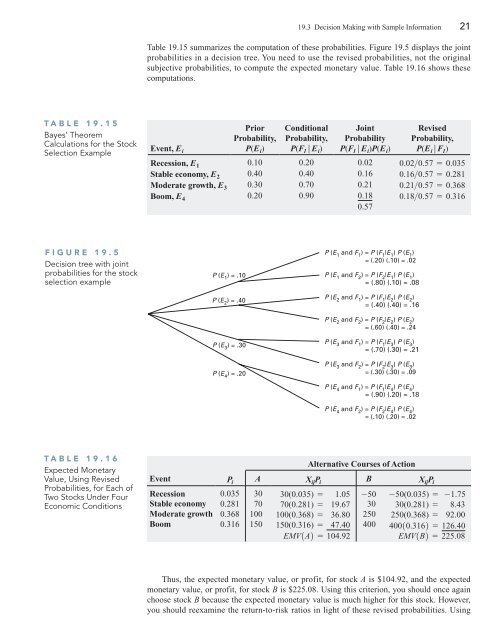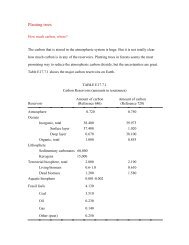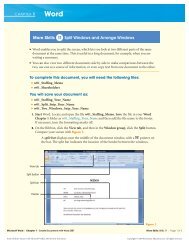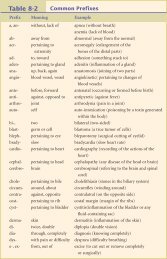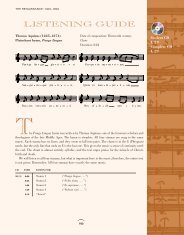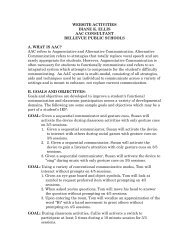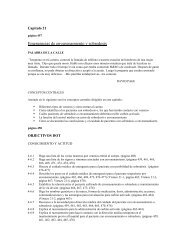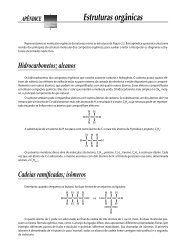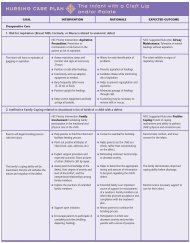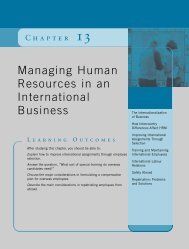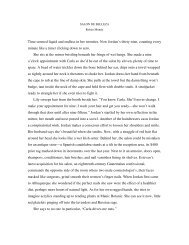19.1 Payoff Tables and Decision Trees
19.1 Payoff Tables and Decision Trees
19.1 Payoff Tables and Decision Trees
Create successful ePaper yourself
Turn your PDF publications into a flip-book with our unique Google optimized e-Paper software.
TABLE <strong>19.1</strong>5<br />
Bayes’ Theorem<br />
Calculations for the Stock<br />
Selection Example<br />
FIGURE 19.5<br />
<strong>Decision</strong> tree with joint<br />
probabilities for the stock<br />
selection example<br />
TABLE <strong>19.1</strong>6<br />
Expected Monetary<br />
Value, Using Revised<br />
Probabilities, for Each of<br />
Two Stocks Under Four<br />
Economic Conditions<br />
P (E 1 ) = .10<br />
P (E 2 ) = .40<br />
P (E 3 ) = .30<br />
P (E 4 ) = .20<br />
19.3 <strong>Decision</strong> Making with Sample Information 21<br />
Table <strong>19.1</strong>5 summarizes the computation of these probabilities. Figure 19.5 displays the joint<br />
probabilities in a decision tree. You need to use the revised probabilities, not the original<br />
subjective probabilities, to compute the expected monetary value. Table <strong>19.1</strong>6 shows these<br />
computations.<br />
Event, E i<br />
Prior<br />
Probability,<br />
P(E i)<br />
Conditional<br />
Probability,<br />
P(F 1|E i)<br />
Joint<br />
Probability<br />
P(F 1|E i)P(E i)<br />
P (E 1 <strong>and</strong> F 1 ) = P (F 1 |E 1 ) P (E 1 )<br />
= (.20) (.10) = .02<br />
P (E 1 <strong>and</strong> F 2 ) = P (F 2 |E 1 ) P (E 1 )<br />
= (.80) (.10) = .08<br />
P (E 2 <strong>and</strong> F 1 ) = P (F 1 |E 2 ) P (E 2 )<br />
= (.40) (.40) = .16<br />
P (E 2 <strong>and</strong> F 2 ) = P (F 2 |E 2 ) P (E 2 )<br />
= (.60) (.40) = .24<br />
P (E 3 <strong>and</strong> F 1 ) = P (F 1 |E 3 ) P (E 3 )<br />
= (.70) (.30) = .21<br />
P (E 3 <strong>and</strong> F 2 ) = P (F 2 |E 3 ) P (E 3 )<br />
= (.30) (.30) = .09<br />
P (E 4 <strong>and</strong> F 1 ) = P (F 1 |E 4 ) P (E 4 )<br />
= (.90) (.20) = .18<br />
P (E 4 <strong>and</strong> F 2 ) = P (F 2 |E 4 ) P (E 4 )<br />
= (.10) (.20) = .02<br />
Revised<br />
Probability,<br />
P(E i|F 1)<br />
Recession, E 1 0.10 0.20 0.02 0.02>0.57 = 0.035<br />
Stable economy, E 2 0.40 0.40 0.16 0.16>0.57 = 0.281<br />
Moderate growth, E 3 0.30 0.70 0.21 0.21>0.57 = 0.368<br />
Boom, E 4 0.20 0.90 0.18 0.18>0.57 = 0.316<br />
0.57<br />
Alternative Courses of Action<br />
Event Pi A XijPi B XijPi Recession 0.035 30 30(0.035) = 1.05 -50 -50(0.035) = -1.75<br />
Stable economy 0.281 70 70(0.281) = 19.67 30 30(0.281) = 8.43<br />
Moderate growth 0.368 100 100(0.368) = 36.80 250 250(0.368) = 92.00<br />
Boom 0.316 150 150(0.316) = 47.40 400 40010.3162 = 126.40<br />
EMV1A2 = 104.92 EMV1B2 = 225.08<br />
Thus, the expected monetary value, or profit, for stock A is $104.92, <strong>and</strong> the expected<br />
monetary value, or profit, for stock B is $225.08. Using this criterion, you should once again<br />
choose stock B because the expected monetary value is much higher for this stock. However,<br />
you should reexamine the return-to-risk ratios in light of these revised probabilities. Using


